power steering SATURN RELAY 2007 Owners Manual
[x] Cancel search | Manufacturer: SATURN, Model Year: 2007, Model line: RELAY, Model: SATURN RELAY 2007Pages: 570, PDF Size: 3.41 MB
Page 271 of 570
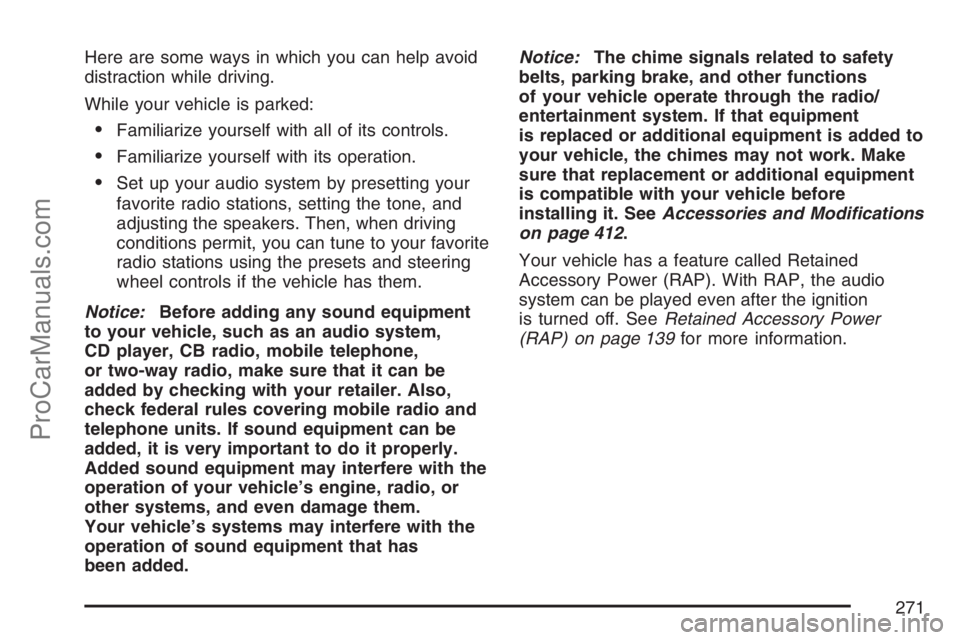
Here are some ways in which you can help avoid
distraction while driving.
While your vehicle is parked:
Familiarize yourself with all of its controls.
Familiarize yourself with its operation.
Set up your audio system by presetting your
favorite radio stations, setting the tone, and
adjusting the speakers. Then, when driving
conditions permit, you can tune to your favorite
radio stations using the presets and steering
wheel controls if the vehicle has them.
Notice:Before adding any sound equipment
to your vehicle, such as an audio system,
CD player, CB radio, mobile telephone,
or two-way radio, make sure that it can be
added by checking with your retailer. Also,
check federal rules covering mobile radio and
telephone units. If sound equipment can be
added, it is very important to do it properly.
Added sound equipment may interfere with the
operation of your vehicle’s engine, radio, or
other systems, and even damage them.
Your vehicle’s systems may interfere with the
operation of sound equipment that has
been added.Notice:The chime signals related to safety
belts, parking brake, and other functions
of your vehicle operate through the radio/
entertainment system. If that equipment
is replaced or additional equipment is added to
your vehicle, the chimes may not work. Make
sure that replacement or additional equipment
is compatible with your vehicle before
installing it. SeeAccessories and Modifications
on page 412.
Your vehicle has a feature called Retained
Accessory Power (RAP). With RAP, the audio
system can be played even after the ignition
is turned off. SeeRetained Accessory Power
(RAP) on page 139for more information.
271
ProCarManuals.com
Page 335 of 570
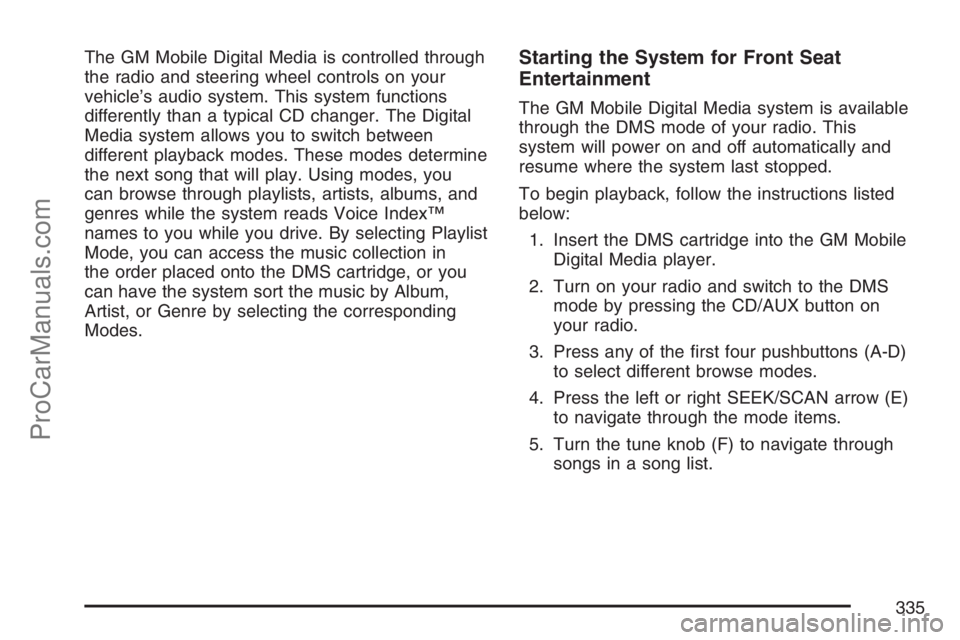
The GM Mobile Digital Media is controlled through
the radio and steering wheel controls on your
vehicle’s audio system. This system functions
differently than a typical CD changer. The Digital
Media system allows you to switch between
different playback modes. These modes determine
the next song that will play. Using modes, you
can browse through playlists, artists, albums, and
genres while the system reads Voice Index™
names to you while you drive. By selecting Playlist
Mode, you can access the music collection in
the order placed onto the DMS cartridge, or you
can have the system sort the music by Album,
Artist, or Genre by selecting the corresponding
Modes.Starting the System for Front Seat
Entertainment
The GM Mobile Digital Media system is available
through the DMS mode of your radio. This
system will power on and off automatically and
resume where the system last stopped.
To begin playback, follow the instructions listed
below:
1. Insert the DMS cartridge into the GM Mobile
Digital Media player.
2. Turn on your radio and switch to the DMS
mode by pressing the CD/AUX button on
your radio.
3. Press any of the �rst four pushbuttons (A-D)
to select different browse modes.
4. Press the left or right SEEK/SCAN arrow (E)
to navigate through the mode items.
5. Turn the tune knob (F) to navigate through
songs in a song list.
335
ProCarManuals.com
Page 365 of 570
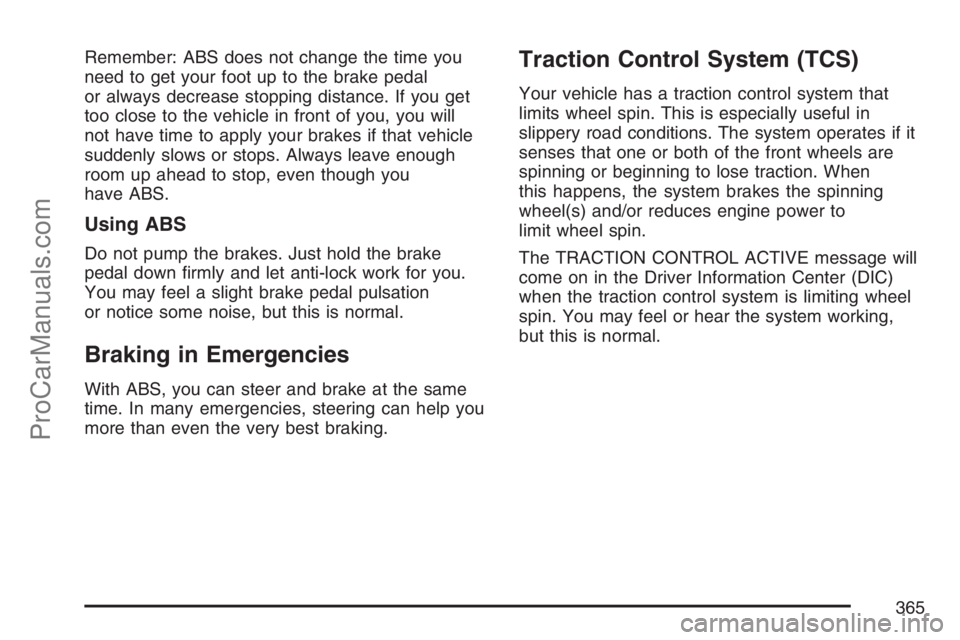
Remember: ABS does not change the time you
need to get your foot up to the brake pedal
or always decrease stopping distance. If you get
too close to the vehicle in front of you, you will
not have time to apply your brakes if that vehicle
suddenly slows or stops. Always leave enough
room up ahead to stop, even though you
have ABS.
Using ABS
Do not pump the brakes. Just hold the brake
pedal down �rmly and let anti-lock work for you.
You may feel a slight brake pedal pulsation
or notice some noise, but this is normal.
Braking in Emergencies
With ABS, you can steer and brake at the same
time. In many emergencies, steering can help you
more than even the very best braking.
Traction Control System (TCS)
Your vehicle has a traction control system that
limits wheel spin. This is especially useful in
slippery road conditions. The system operates if it
senses that one or both of the front wheels are
spinning or beginning to lose traction. When
this happens, the system brakes the spinning
wheel(s) and/or reduces engine power to
limit wheel spin.
The TRACTION CONTROL ACTIVE message will
come on in the Driver Information Center (DIC)
when the traction control system is limiting wheel
spin. You may feel or hear the system working,
but this is normal.
365
ProCarManuals.com
Page 369 of 570
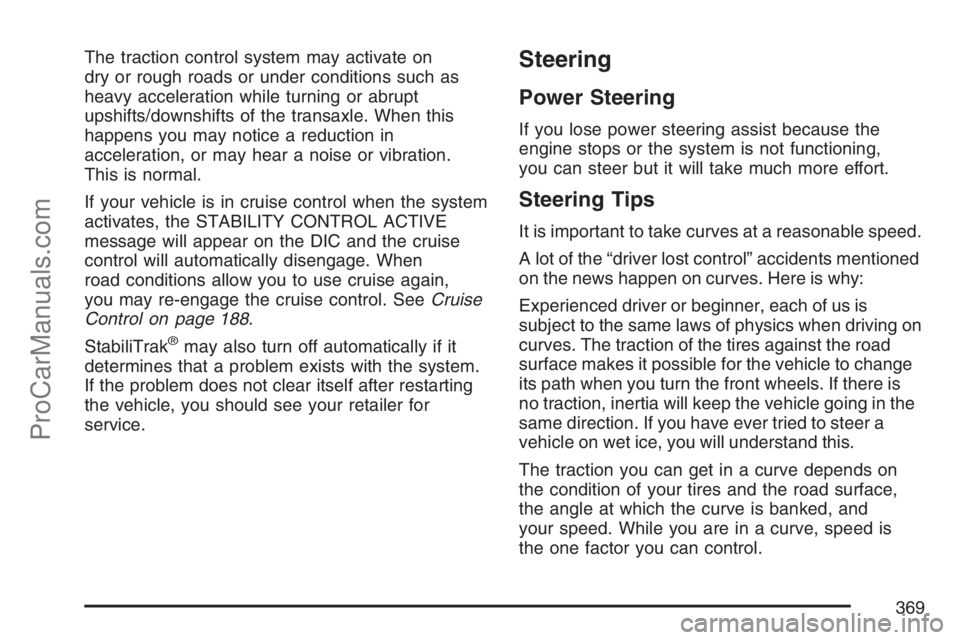
The traction control system may activate on
dry or rough roads or under conditions such as
heavy acceleration while turning or abrupt
upshifts/downshifts of the transaxle. When this
happens you may notice a reduction in
acceleration, or may hear a noise or vibration.
This is normal.
If your vehicle is in cruise control when the system
activates, the STABILITY CONTROL ACTIVE
message will appear on the DIC and the cruise
control will automatically disengage. When
road conditions allow you to use cruise again,
you may re-engage the cruise control. SeeCruise
Control on page 188.
StabiliTrak
®may also turn off automatically if it
determines that a problem exists with the system.
If the problem does not clear itself after restarting
the vehicle, you should see your retailer for
service.
Steering
Power Steering
If you lose power steering assist because the
engine stops or the system is not functioning,
you can steer but it will take much more effort.
Steering Tips
It is important to take curves at a reasonable speed.
A lot of the “driver lost control” accidents mentioned
on the news happen on curves. Here is why:
Experienced driver or beginner, each of us is
subject to the same laws of physics when driving on
curves. The traction of the tires against the road
surface makes it possible for the vehicle to change
its path when you turn the front wheels. If there is
no traction, inertia will keep the vehicle going in the
same direction. If you have ever tried to steer a
vehicle on wet ice, you will understand this.
The traction you can get in a curve depends on
the condition of your tires and the road surface,
the angle at which the curve is banked, and
your speed. While you are in a curve, speed is
the one factor you can control.
369
ProCarManuals.com
Page 409 of 570
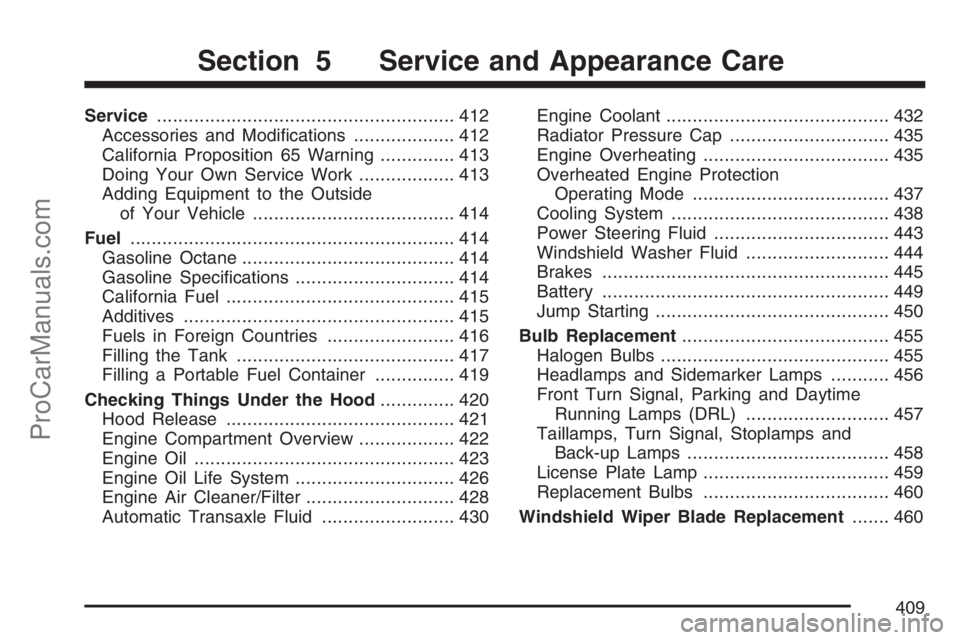
Service........................................................ 412
Accessories and Modi�cations................... 412
California Proposition 65 Warning.............. 413
Doing Your Own Service Work.................. 413
Adding Equipment to the Outside
of Your Vehicle...................................... 414
Fuel............................................................. 414
Gasoline Octane........................................ 414
Gasoline Speci�cations.............................. 414
California Fuel........................................... 415
Additives................................................... 415
Fuels in Foreign Countries........................ 416
Filling the Tank......................................... 417
Filling a Portable Fuel Container............... 419
Checking Things Under the Hood.............. 420
Hood Release........................................... 421
Engine Compartment Overview.................. 422
Engine Oil................................................. 423
Engine Oil Life System.............................. 426
Engine Air Cleaner/Filter............................ 428
Automatic Transaxle Fluid......................... 430Engine Coolant.......................................... 432
Radiator Pressure Cap.............................. 435
Engine Overheating................................... 435
Overheated Engine Protection
Operating Mode..................................... 437
Cooling System......................................... 438
Power Steering Fluid ................................. 443
Windshield Washer Fluid........................... 444
Brakes...................................................... 445
Battery...................................................... 449
Jump Starting............................................ 450
Bulb Replacement....................................... 455
Halogen Bulbs........................................... 455
Headlamps and Sidemarker Lamps........... 456
Front Turn Signal, Parking and Daytime
Running Lamps (DRL)........................... 457
Taillamps, Turn Signal, Stoplamps and
Back-up Lamps...................................... 458
License Plate Lamp................................... 459
Replacement Bulbs................................... 460
Windshield Wiper Blade Replacement....... 460
Section 5 Service and Appearance Care
409
ProCarManuals.com
Page 423 of 570
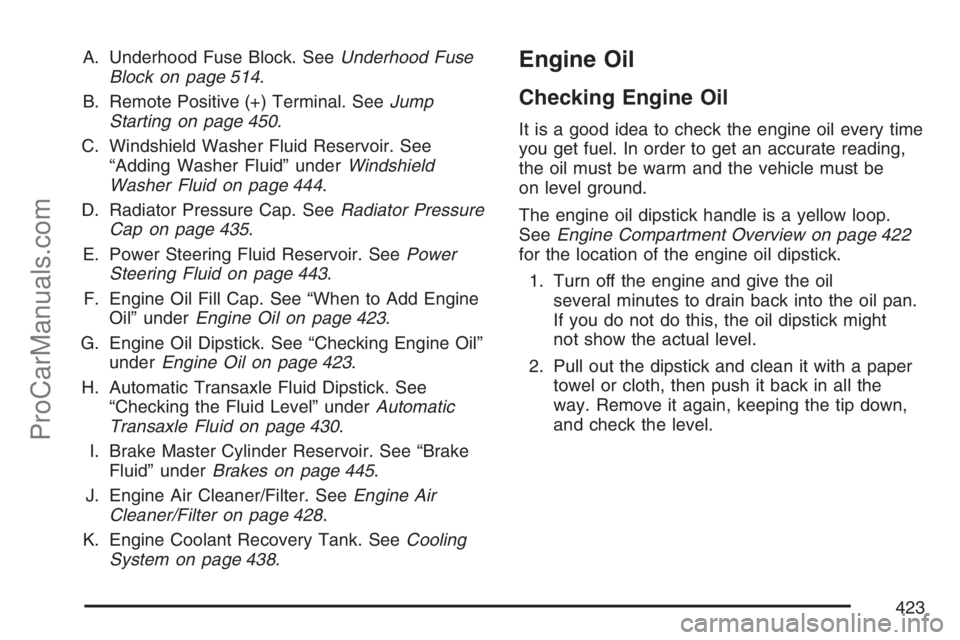
A. Underhood Fuse Block. SeeUnderhood Fuse
Block on page 514.
B. Remote Positive (+) Terminal. SeeJump
Starting on page 450.
C. Windshield Washer Fluid Reservoir. See
“Adding Washer Fluid” underWindshield
Washer Fluid on page 444.
D. Radiator Pressure Cap. SeeRadiator Pressure
Cap on page 435.
E. Power Steering Fluid Reservoir. SeePower
Steering Fluid on page 443.
F. Engine Oil Fill Cap. See “When to Add Engine
Oil” underEngine Oil on page 423.
G. Engine Oil Dipstick. See “Checking Engine Oil”
underEngine Oil on page 423.
H. Automatic Transaxle Fluid Dipstick. See
“Checking the Fluid Level” underAutomatic
Transaxle Fluid on page 430.
I. Brake Master Cylinder Reservoir. See “Brake
Fluid” underBrakes on page 445.
J. Engine Air Cleaner/Filter. SeeEngine Air
Cleaner/Filter on page 428.
K. Engine Coolant Recovery Tank. SeeCooling
System on page 438.Engine Oil
Checking Engine Oil
It is a good idea to check the engine oil every time
you get fuel. In order to get an accurate reading,
the oil must be warm and the vehicle must be
on level ground.
The engine oil dipstick handle is a yellow loop.
SeeEngine Compartment Overview on page 422
for the location of the engine oil dipstick.
1. Turn off the engine and give the oil
several minutes to drain back into the oil pan.
If you do not do this, the oil dipstick might
not show the actual level.
2. Pull out the dipstick and clean it with a paper
towel or cloth, then push it back in all the
way. Remove it again, keeping the tip down,
and check the level.
423
ProCarManuals.com
Page 443 of 570

7. Then replace the pressure cap. At any time
during this procedure if coolant begins to �ow
out of the �ller neck, reinstall the pressure cap.
Be sure the pressure cap is closed properly.
8. Then �ll the coolant recovery tank to the full
cold mark.
9. Put the cap back on the coolant recovery tank.Power Steering Fluid
The power steering �uid
reservoir is located
toward the rear of the
engine compartment on
the passenger’s side
of the vehicle. See
Engine Compartment
Overview on page 422
for reservoir location.
When to Check Power Steering Fluid
It is not necessary to regularly check power
steering �uid unless you suspect there is a leak
in the system or you hear an unusual noise.
A �uid loss in this system could indicate a problem.
Have the system inspected and repaired.
Filling the Coolant Recovery Tank
443
ProCarManuals.com
Page 444 of 570

How to Check Power Steering Fluid
To check the power steering �uid, do the following:
1. Turn the key off and let the engine
compartment cool down.
2. Wipe the cap and the top of the reservoir
clean.
3. Unscrew the cap and wipe the dipstick with
a clean rag.
4. Replace the cap and completely tighten it.
5. Remove the cap again and look at the
�uid level on the dipstick.
The �uid level should be somewhere within the
cross-hatched area on the dipstick. If the �uid is
at the ADD mark, you should add �uid.
What to Use
To determine what kind of �uid to use, see
Recommended Fluids and Lubricants on page 530.
Always use the proper �uid. Failure to use the
proper �uid can cause leaks and damage hoses
and seals.
Windshield Washer Fluid
What Washer Fluid to Use
When you need windshield washer �uid, be sure
to read the manufacturer’s instructions before
use. If you will be operating your vehicle in an area
where the temperature may fall below freezing,
use a �uid that has sufficient protection against
freezing.
Adding Washer Fluid
Open the cap with the
washer symbol on it.
Add washer �uid
until the tank is full. See
Engine Compartment
Overview on page 422
for reservoir location.
444
ProCarManuals.com
Page 466 of 570

(B) Tire Width:The three-digit number indicates
the tire section width in millimeters from sidewall
to sidewall.
(C) Aspect Ratio:A two-digit number that
indicates the tire height-to-width measurements.
For example, if the tire size aspect ratio is
60, as shown in item C of the illustration, it would
mean that the tire’s sidewall is 60 percent as
high as it is wide.
(D) Construction Code:A letter code is used
to indicate the type of ply construction in the tire.
The letter R means radial ply construction; the
letter D means diagonal or bias ply construction;
and the letter B means belted-bias ply
construction.
(E) Rim Diameter:Diameter of the wheel in
inches.
(F) Service Description:These characters
represent the load range and speed rating of the
tire. The load index represents the load carry
capacity a tire is certi�ed to carry. The load index
can range from 1 to 279. The speed rating is
the maximum speed a tire is certi�ed to carry
a load. Speed ratings range from A to Z.Tire Terminology and De�nitions
Air Pressure:The amount of air inside the tire
pressing outward on each square inch of the
tire. Air pressure is expressed in pounds
per square inch (psi) or kilopascal (kPa).
Accessory Weight:This means the combined
weight of optional accessories. Some examples of
optional accessories are, automatic transmission/
transaxle, power steering, power brakes, power
windows, power seats, and air conditioning.
Aspect Ratio:The relationship of a tire’s height
to its width.
Belt:A rubber coated layer of cords that is
located between the plies and the tread. Cords
may be made from steel or other reinforcing
materials.
Bead:The tire bead contains steel wires wrapped
by steel cords that hold the tire onto the rim.
Bias Ply Tire:A pneumatic tire in which the plies
are laid at alternate angles less than 90 degrees
to the centerline of the tread.
466
ProCarManuals.com
Page 513 of 570

Fuses Usage
1 Trunk, Door Locks
2 Electronic Level Control
3 Rear Wiper
4 Radio, DVD Player
5 Interior Lamps
6 OnStar
®
7 Keyless Entry Module
8Cluster, Heating, Ventilation,
Air Conditioning
9 Cruise Switch
10 Steering Wheel Illumination
11 Power Mirror
12 Stoplamp, Turn Lamps
13 Heated Seats
14 Blank
15 Electronic Level Control
513
ProCarManuals.com